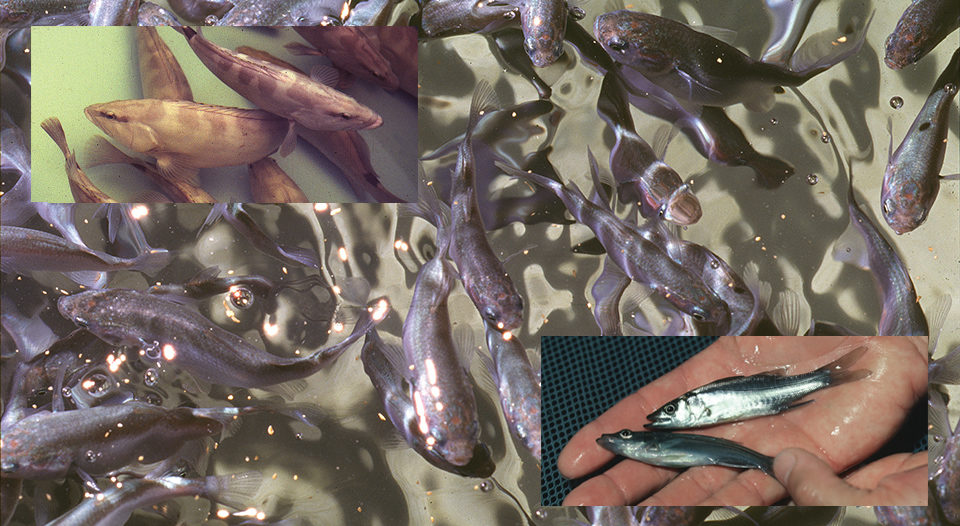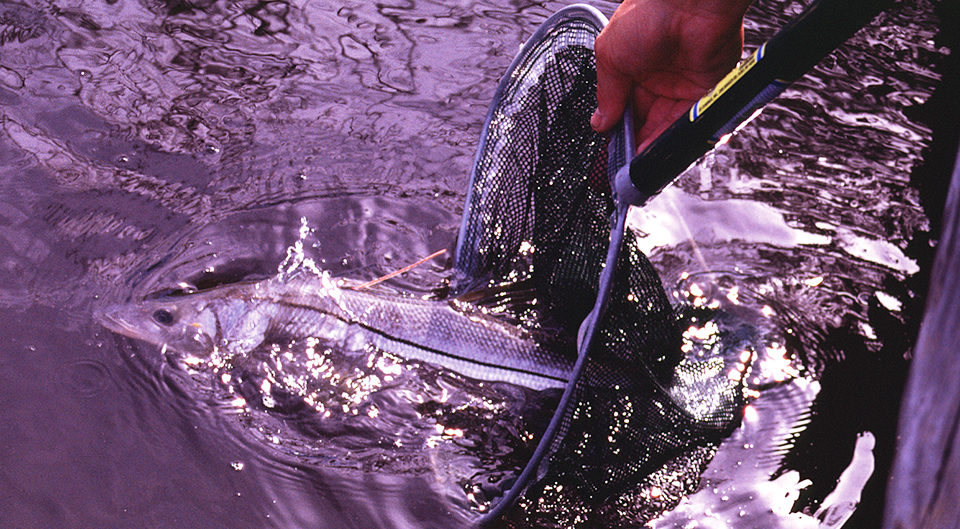Preconditioning can help released fish adapt more quickly

Most mosquito impoundments in east-central Florida, USA, were created about 50 years ago by diking off marshes and swamps so they could be kept flooded during the summer peak mosquito-breeding season to minimize the amount of exposed mud available for egg laying. This also reduced nursery habitat quality and access for many fish and invertebrates.
Since 1982, the St. Lucie County Mosquito Control District has restored about 1,620 ha of impoundments so that some 100 kinds of fish – and sometimes even corals and sponges – thrive in parts of them. Previously, only a few species like topminnows, which do not depend on constant dissolved oxygen in the water column, could survive.
Stocking fish in the impoundments has helped demonstrate improved habitat quality. It also is one way to give hatchery fish a transition to open water.
Stocked fish
Reared striped mullet (Mugil cephalus), sheepshead (Archosargus probatocephalus) and common snook (Centropomus undecimalis) were stocked in partially restored impoundments. All these euryhaline fish are able to adapt to a wide range of salinities.
Striped mullet are omnivorous, temperate to tropical, schooling coastal fish. Sheepshead also are temperate to tropical and omnivorous fish, but territorial in nature. Common snook are carnivorous, tropical, schooling coastal fish. Common snook was a species of special concern in Florida from 1982 to 2001 that still is on the Florida protected species list
Nassau groupers (Epinephelus striatus), which were stocked in another project on a coral reef, are tropical to temperate, territorial, carnivorous reef fish that cannot tolerate low salt content of water. Nassau groupers are considered threatened or endangered.
For stocking in grow-out tanks or small, protected ponds and cages, fully developed juveniles of about 50 mm total length are a good minimum. For less-protected ponds and cages, the fish should be larger. For stocking in natural environments, the larger the fish, the better. It is important to stock them at a size at which habitat and/or food scarcity are not limiting.
As snook grow from 25 to 250 mm in length, they depend on shelter from shallow weeds or mangroves, then grass beds or equivalent habitats. As Nassau groupers grow from 50 to 250 mm, they move from shallow backreefs to shallow forereefs. Sheepshead live close to or in structures from the early juvenile stage onward. Mullet tend to stay in large schools in open shallow or deep water from the early juvenile stage onward.
Varied releases
During 1984, the authors released 1,000 untagged 8-cm sheepshead in an impoundment. In 1985, 35, 15- to 30-cm snook were released in another impoundment. About 4,500 snook were raised in a 1995-1996 demonstration project and most were given to other organizations for stocking. The best hatchery survival was 7 percent, but that can be increased to at least 15 percent just by controlling cannibalism. Survival of 5-cm juveniles was 100 percent after six hours of truck transport and 12 hours in holding tanks.
Two months after 2,368 snook were placed in two 0.1-ha ponds with only live natural foods, overall survival was 94 percent. In the pond with a near-optimal mean temperature of 28 degrees-C, mean growth was a normal 1.07 millimeters per day, while in the pond at 21 degrees-C, growth was a low 0.20 millimeters per day. In 1996, on an experimental scale, hatchery cost was less than U.S. $1 per fish, which can be reduced greatly with larger scale.
During 1996-1997, 3,332 tagged striped mullet of 8 to 18 cm were stocked and monitored in two other impoundments to study their behaviors. The partial confinement of the impoundments allowed close observation and comparative examinations of wild and reared mullet for growth and survival under nearly natural physical, social, nutritional, and predatory conditions.
In 2000, the authors released 800 snook in a mangrove swamp at Fort Lauderdale, Florida. All the snook raised 1995-2003 were robust and disease-free, with no abnormalities found by an aquatic veterinarian or the state health lab.
During 2002-2003, 156, 45- to 66-cm dart-tagged snook were released in two other impoundments. Three were seen and four were caught up to 42 km from the release site and 349 days after release. All were in schools of wild snook and reported to look healthy. Six of 15 snook with ultrasonic transmitters were tracked in the estuary up to 8 km away and 353 days after release.
In the impoundments, both hatchery and wild snook seem to prefer areas with the most cover and side channels, as long as the depth is comfortable and there is an escape route. Outside the impoundments, both prefer places where they can stay out of strong currents but catch food that is passing by or is attracted to the area, such as bends in channels, corners of seawalls, and lighted docks at night. Both reared and wild snook are shy and quick to hide from possible predators.
During 1993, 27 dart-tagged Nassau groupers of 30 to 38 cm length were released on a shallow open-ocean reef south of St. Thomas, U.S. Virgin Islands, and monitored by a diving team. Because groupers become territorial as they mature, they eventually spread out to avoid conflict. However, at least two of the released fish stayed in the area over 200 days, and one was seen at the site after 16 months.

Fish behaviors
Much behavior in these fish is innate. Striped mullet are foragers that are always ready to flee. Sheepshead are grazers and not easily disturbed. Common snook are raptors, alert and suspicious of any movement or change in light. Nassau groupers are ambushers, bold and curious around humans unless mistreated.
As they transform into juveniles, reared striped mullet swim around tanks in a school as if migrating. They seem just as fearful as wild mullet and thoroughly scour the tank walls and bottoms for food. When released in a shallow estuary, mullet swam away in a school.
Common snook juveniles are almost as shy as mullet, but stay near the bottom except when feeding. When released in shallow estuaries, snook swam away in small groups, hid between mangrove roots, and soon began chasing prey-size wild fish.
Once sheepshead are juveniles with well-developed incisors, they thoroughly scrape algae from the tank walls. When released in a shallow estuary, they individually swam between mangrove roots and soon began scraping food from the roots.
Floating milk crates were used as habitat to accelerate the transformation of Nassau grouper larvae to juveniles in the hatchery. This species is very adaptable during rearing, and will even eat directly from a person’s hand immediately after being moved between tanks.
After being raised on dry pellets for two years, juvenile groupers immediately ate live goldfish, minnows, and fiddler crabs when first offered, and needed only a few hours to finish eating their first few dozen live shrimp. A little later, several also learned to knock large iso-pods off the tank wall several centimeters above the water by spitting streams of water like archer fish, and then ate them.
When released on a 15-m deep reef after spending several days in a holding cage, the groupers immediately went to a cleaning station to have parasites acquired in the cage removed from their mouths and gills by cleaner gobies and shrimp, settled into the reef, and like wild groupers, hunted alongside a moray eel and octopus within two days.
Perspectives
Preconditioning can help released fish adapt more quickly, but the swimming, feeding, social, and fright behaviors of these four species when reared are surprisingly similar to those of wild fish. In addition to providing biological needs and minimizing predation, good release habitats can help limit stress and disease. For example, stocking in fresh water can help protect against vibriosis and some parasites, and stocking in salt water can help protect against fungi.
These studies showed that larger fish survive better than small ones, but also that small fish can survive well if enough good habitat and food are available. The hatchery fish apparently have most of the same survival instincts as their wild counterparts. Within several hours after release, they become familiar with their new surroundings and start behaving and feeding like wild fish.
(Editor’s Note: This article was originally published in the July/August 2007 print edition of the Global Aquaculture Advocate.)
Now that you've finished reading the article ...
… we hope you’ll consider supporting our mission to document the evolution of the global aquaculture industry and share our vast network of contributors’ expansive knowledge every week.
By becoming a Global Seafood Alliance member, you’re ensuring that all of the pre-competitive work we do through member benefits, resources and events can continue. Individual membership costs just $50 a year. GSA individual and corporate members receive complimentary access to a series of GOAL virtual events beginning in April. Join now.
Not a GSA member? Join us.
Authors
-
John W. Tucker, Jr., Ph.D.
St. Lucie County Mosquito Control District
3150 Will Fee Road
Fort Pierce, Florida 34982 USA -
Sarah Blain Kennedy, DVM
Indian River Institute, Inc.
Vero Beach, Florida, USA -
James R. David, M.S.
St. Lucie County Mosquito Control District
Related Posts

Health & Welfare
Acclimating shrimp postlarvae before pond stocking
Shrimp postlarvae acclimation before stocking into the various growout systems (ponds, raceways, tanks) is a critical – and often overlooked, sometimes taken for granted – step in the shrimp culture process. Various water quality parameters should be changed slowly so that the young shrimp have the time to gradually adapt to the new conditions.

Health & Welfare
10 paths to low productivity and profitability with tilapia in sub-Saharan Africa
Tilapia culture in sub-Saharan Africa suffers from low productivity and profitability. A comprehensive management approach is needed to address the root causes.

Responsibility
A look at various intensive shrimp farming systems in Asia
The impact of diseases led some Asian shrimp farming countries to develop biofloc and recirculation aquaculture system (RAS) production technologies. Treating incoming water for culture operations and wastewater treatment are biosecurity measures for disease prevention and control.

Innovation & Investment
AI platform delivers data to fish and shrimp farmers
XpertSea does more than count fish. It uses AI and computer vision to calculate growth rates and optimal harvest dates to improve aquaculture efficiency.


